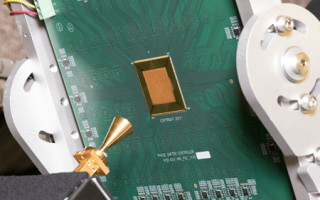CASA radar: Detecting danger at a distance
NewsJanuary 09, 2018

MALIBU, Calif. Research and development lab HRL Laboratories has announced the development of a high-resolution, low-power radar antenna array (coded aperture subreflector array or CASA) that the company says can potentially see weapons or explosives concealed on a person at tactically safe distances. HRL Laboratories is owned by The Boeing Company and General Motors; the R&D lab specializes in research into sensors and materials, information and systems sciences, applied electromagnetics, and microelectronics.
With a CASA scanner, someone concealing a weapon like a suicide bomb could be detected while the attacker was still far enough away to make a sudden detonation far less lethal. The low power usage and scalability of the CASA array, say HRL officials, makes it usable in a number of scenarios, including security scanners, as the "eyes and ears" of robots, or integrated into autonomous vehicles.
The CASA radar array scans high-resolution 3-D images with a digitally synthesized beam, which means that the array itself does not need to move but is able to create the images by digitally processing the data collected as the beam reflects off targets.
HRL’s Microelectronics Laboratory used a tiling method to make the radar antenna array, with one-inch-square radio frequency (RF) tiles. “The tiles make the array scalable to whatever size is needed for a particular task. You can add more tiles over a fairly large area and get thousands of pixels in your images. Also, we fabricated the tile arrays with wafer-scale integration that really keeps costs in line,” said Jonathan Lynch, HRL’s principal investigator on the project.
The CASA array operates at a very high frequency; the higher the frequency, the narrower the radar beam, and the greater the image resolution: “With such high frequency, we fabricated a 1,024-element radar antenna array that is about an inch on a side. The little antenna elements are only 700 microns [one micron = one thousandth of a millimeter] apart, based on spacing them half a wavelength apart. That’s how small the wavelength of the beam is,” Lynch said.
HRL enabled the CASA by combining coded aperture radar with and 3D integration. “The heart of the technology is our GaN T4 MMIC [gallium nitride (GaN) T4 monolithic microwave integrated circuits],” said HRL researcher Hasan Sharifi. “These circuits operate at very high frequency, 235 gigahertz, allowing us to pack many elements into a tiny area.”






